|
Justin's Masters Thesis Work
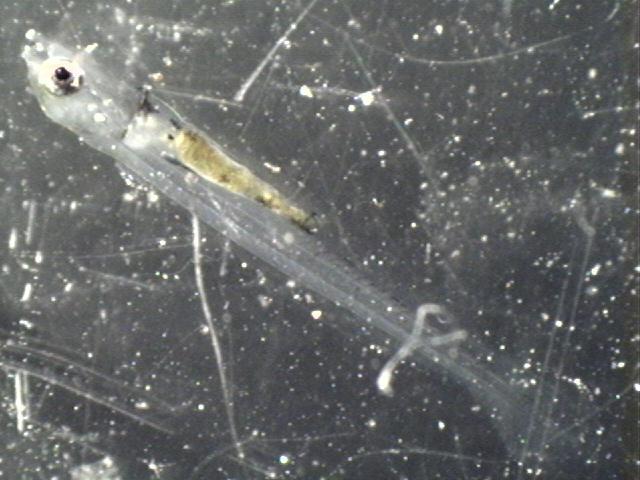
Three years ago I embarked on a quest to determine why yellow perch, Perca flavescens in Lake Michigan have been doing so
poorly in the last decade or so. I spent months reading journal articles about limnology, ecology, fish biology,
and recruitment fisheries biology. I read technical reports and minutes from meetings of the great lakes fishery
comission that were difficult to find. I now have a stack of papers nearly a foot thick that I have read.
Once I had an idea of what the problem may have been and a wealth of information on what it was not, I conducted
an experiment to test my hypothesis.
In all the papers that I read that discussed the diet of larval yellow perch I noticed that rarely did rotifers
show up in any diet studies, yet many papers showed that perch were gape limited during early life stages. For
those of you who are not biologists, rotifers are the smallest multicellular organisms on the planet and gape limited
means that yellow perch have a rough time eating larger food items. So, naturally I thought that there was a
discrepancy. Why would perch not eat rotifers during the first few weeks after hatching? Had rotifers been overlooked
by other researchers? My current research indicates that the later may be true.
|
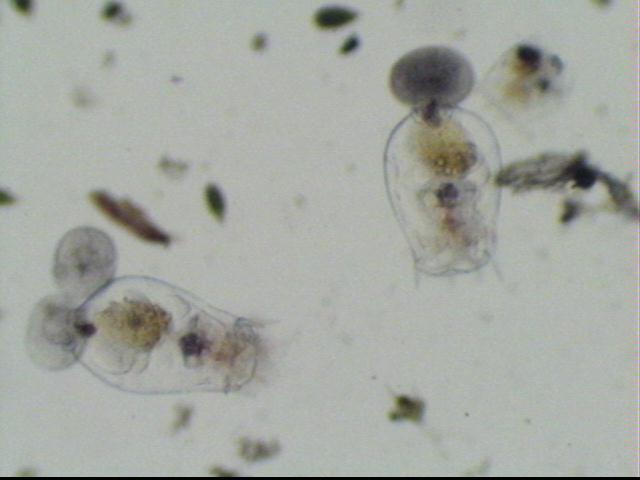
Above: Brachionus calyciflorus, rotifer that I used in my experiments with yellow perch.
|

Above: A copepod nauplius. These have been found in diet studies of larval yellow perch.
|
| In guts of yellow perch, rotifers tend to be quickly digested due to their small size and soft bodies. However, Nauplii with their hardened
exoskeletons are not digested nearly as fast. The only part of rotifers that is usually visible in guts of larval fishes is therefore only their
mouth parts that are called trophi. As you can imagine, the mouthparts of the smallest multicellular organisms are very small indeed, whereas an
entire exoskeleton of a nauplius, or of even larger crustaceans like adult copepods or small cladocerans are very
large. In fact, if you look under a microscope they seem to jump right out at you. Just take a look at the picture to the right if you dont believe me.
Contrast that photo with the photo below it containing 7 rotifer trophi at the same magnification. Once, the comparisons are made, it seems easy to
suspect that researchers would overlook what appears to be simply detritus when in actuality it shows that perch had consumed rotifers.
|
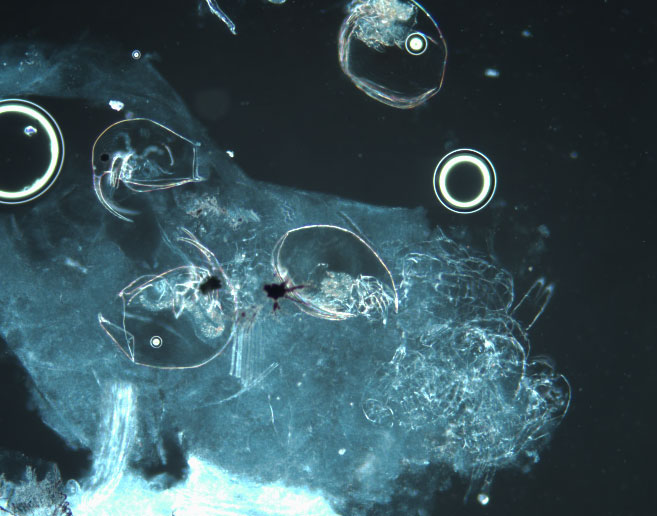
Above: Photo of gut contents in a 27-day old yellow perch. Small cladocerans are readily visible, as well as copepod exoskeletons in the lower right corner.
|
| After doing an experiment in which I fed newly hatched larval perch one of four food treatments including no food, a diet of cultured rotifers, 100-153 um and 153-243 um size classes (both had high densities of nauplii as well as some adult copepods and cladocerans), I found that
rotifers may be important to survival of larval perch through the 'critical period'. Nauplii become important soon after rotifers, and larger food items like copepods and small cladocerans become important as larval fish mature. You may be wondering at this point, why does that matter?
Well, without getting long winded, managers in the great lakes attempt to simulate populations of fishes using computer models. Computer models are only as accurate as the information entered into them. Prior to this experiment many models have attempted to predict
'recruitment' of yellow perch, however none have been very successful in explaining perch population dynamics. Perhaps the reason is because they did not include rotifer densities, when rotifers are in fact important in the diet of larval yellow perch. Only more
models and experiments will tell. Meanwhile, other hypotheses must also be tested.
|
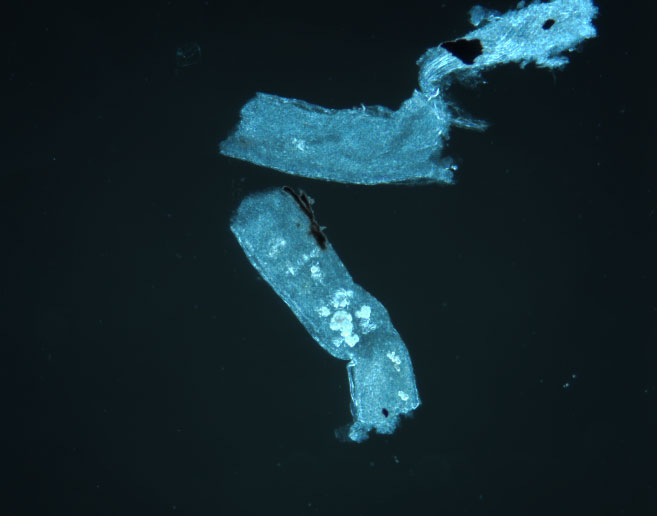
Above: 11 day old yellow perch gut containing 7 rotifer trophi. The trophi are the hazy whitish spots. You can't determine that they are trophi unless you use higher magnification.
|
| In my experiments, I had problems with survival and poor feeding by my larval perch. I tried
various methods to increase feeding and survival. It wasn't until last spring I stumbled upon a finding in an aquaculture journal that indicated that
black funnels improved survival of larval perch compared with white funnels. The article cited contrast between prey and their background as the reason
for increased feeding and survival. I conducted an experiment whereby I wrapped aquaria in black plastic and fed newly hatched larval perch cultured rotifers.
The fish could be seen actively feeding, their guts were visibly full, and survival to day 14 was 29%, which was much higher than previous experiments that were
near 0%. The experiment was not conducted on a scale that was conclusive, however this spring I plan on doing similar experiments with black plastic covered aquaria
that will likely strengthen the argument. This brings up another question about recruitment in lake michigan. What if the perch can't see their food to eat it in
Lake Michigan? What factors would affect their ability to see prey?
The only time there would be a black background to contrast prey items in Lake Michigan would be at night. Previous studies have shown that the majority
of feeding by larval perch occurs at night and near the surface (in the first 1m of water). Perch are visual predators and as such some light would be necessary in order
for them to feed effectively. I am currently attempting to find past weather data on cloud cover as well as on moon phases to determine if nighttime light conditions can be
correlated with recruitment of larval perch.
|
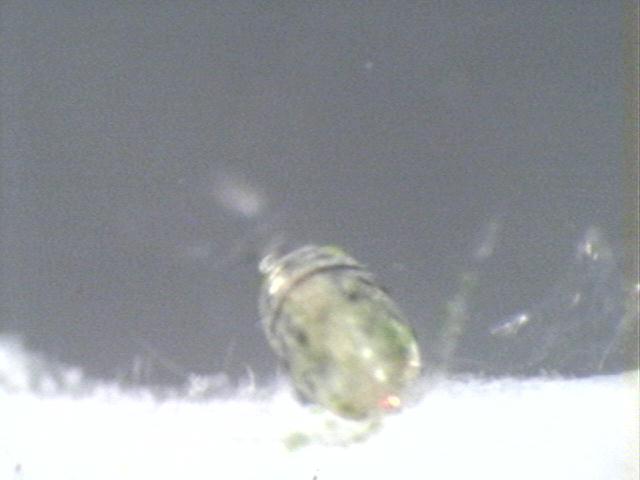
Above: Acanthocyclops vernalis feeding on a larval yellow perch.
Below: Acanthocyclops vernalis under polarized light.
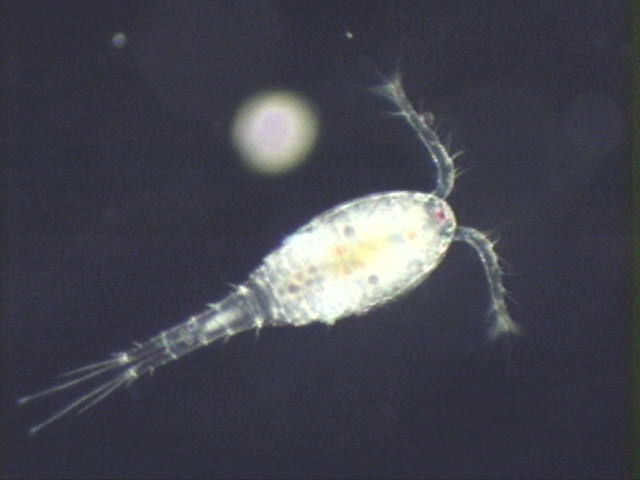
|
Still another aspect of the Lake Michigan food web that may or may not affect yellow perch recruitment is predation. Past studies have indicated that
Alewife may prey on larval yellow perch. There is a correlation between increasing alewife abundance and decreasing
yellow perch abundance. There is also an inverse relationship between spring adult alewife abundance and recruitment of larval yellow perch. However, direct
evidence of predation by alewife has not been found in lake michigan despite repeated efforts to find such evidence.
One predator that has not been considered previously as a problem for yellow perch is the cyclopoid copepod. There is limited evidence that
cyclopoid copepods can attack larval yellow perch, larval walleye, and other fishes. My study showed that the cyclopoid copepod, Acanthocyclops vernalis, can kill and
devour newly hatched larval yellow perch. It is unknown how susceptible yellow perch are to predation, how long they are susceptible, and what conditions would affect
the extent of any predation that may occur.
|
|
Currently I estimate the completion of my thesis in about 1 1/2 to 2 months. I will be presenting my findings at a seminar at Central Michigan University in Brooks hall on Tuesday, April 27, 2004 (room and time to be determined).
I will also be presenting my findings in a poster presentation at IAGLR May 25, 2004 in Waterloo, Ontario.
For those of you who are looking at my website with the idea that you may take me on as a PhD student, please note that this is an informal web page. It does not reflect
my writing style. The goal of this page is simply to explain to a general audience what the purpose of my research has been.
|






